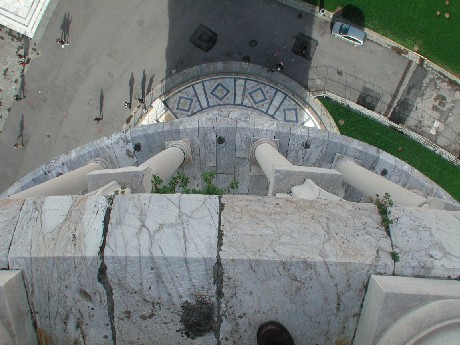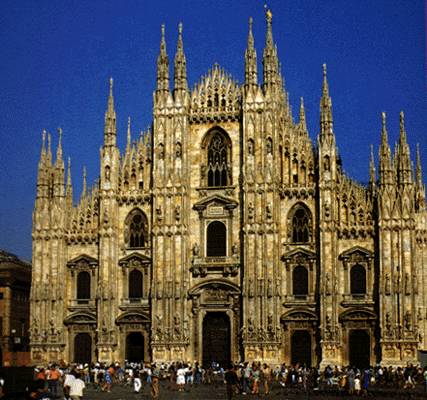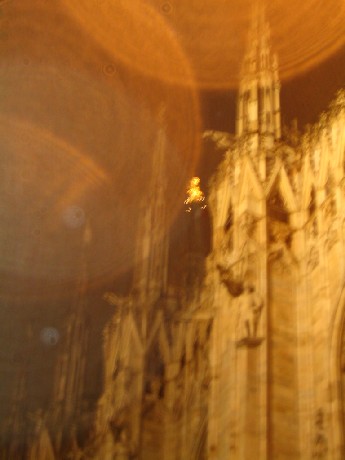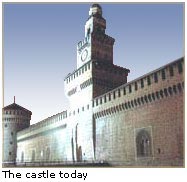%MRC%
A couple of links I found:
- tourist page with a bit of historical info. on St. Peter's
- Altin2001 -- short paper comparing Pantheon, Firenze and St. Peters domes. 'reads like a term paper for a course, turned into a publication? MarkCutkosky April 19 2005.
Hunger is the theme of my life. For now, I will attempt to satisfy it through some really cool architecture! Like this:
 THE TOWER:
THE TOWER: - The tower was begun in 1173, and it has never stood perpendicular to the ground. Pisans have come up with some pretty interesting "theories" as to why this is. One such theory says that the original laborers conspired to make the tower crooked as a way of protesting their low wages. Another one points to William of Innsbruck, a builder who was said to have collaborated with Bonnano Pisano, the tower's architect. Innsbruck is said to have built the tower crooked on purpose as a way of inflicting revenge on society since he himself was a hunchback. The religious explanation states that as the campanile is built on the Campo dei Miracoli, or the Field of Miracles, it is God who has allowed the structure to stand as a way of showing His power. And of course there are theories of curses put on Pisa by the Saracens or the Genose, who were bitter rivals.
- The scientific mind tells you these are probably not the entire cause. So we ask, why? The Campo dei Miracoli was actually once a bog, with unstable subsoil that allowed one side to compress more than the other. So when the tower started leaning after the third story was built and the builders tried to compensate by making one side heavier than the other, the tower began leaning the other way. The tower we see today is leaning the opposite direction from the one it was leaning it originally. (Shrady 2003)
- Since the tower is supported by colums on each of its 8 stories and the middle 6 stories are similar in structure, wouldn't the tension be especially strong on the side that is leaning downward? Since I assume the columns carry weight in addition to the middle marble and rubble part.
- Do the attached columns on the first level support weight better than the the ones on the other stories that are separated?
- As you climb up the tower, the tilt the becomes less and less as you approach the top. This is probably because of the banana shape of the building.
- Do the small arches along each story actually help the weight, or are they just for aesthetic purposes?

 THE DUOMO - Its Gothic-style architecture is immensely different from the Duomo in Florence. It has over 130 spires and over 500 statues, definitely magnificent. Unfortunately when we went to see it when the front was being renovated, so we didn't actually get to see the gorgeous facade. My first encounter with the Duomo was at night, when I saw the light at the top of the tallest spire. The intricate details were definitely very frightening.
Observations on Milan:
Upon entering the Stazione Centrale of Milan, one immediately realizes that Milan is a bigger commercial center than either Florence or Pisa, by its taller "sky-scraper"ish buildings. There are not many, and they are spread out, but a tone of impersonality is set. There exist many more multi-lane roads in Milan, as well as bigger cars. For those with claustrophobia, Milan is a better city for you than Florence! As a sidenote, Milanese Italian is easier to understand (for me) than the Florentine accent.
Last, we have the Castello Sforzesco, the beloved Castle of Milan.
THE DUOMO - Its Gothic-style architecture is immensely different from the Duomo in Florence. It has over 130 spires and over 500 statues, definitely magnificent. Unfortunately when we went to see it when the front was being renovated, so we didn't actually get to see the gorgeous facade. My first encounter with the Duomo was at night, when I saw the light at the top of the tallest spire. The intricate details were definitely very frightening.
Observations on Milan:
Upon entering the Stazione Centrale of Milan, one immediately realizes that Milan is a bigger commercial center than either Florence or Pisa, by its taller "sky-scraper"ish buildings. There are not many, and they are spread out, but a tone of impersonality is set. There exist many more multi-lane roads in Milan, as well as bigger cars. For those with claustrophobia, Milan is a better city for you than Florence! As a sidenote, Milanese Italian is easier to understand (for me) than the Florentine accent.
Last, we have the Castello Sforzesco, the beloved Castle of Milan.
 The Castello Sforzesco is a castle built in the latter 14th century at the time of Galeazzo II Visconti. It was named after Francesco Sforza, who transformed it into a ducal residence in 1450.
The Castello Sforzesco is a castle built in the latter 14th century at the time of Galeazzo II Visconti. It was named after Francesco Sforza, who transformed it into a ducal residence in 1450.
- [[http://www.milanocastello.it] [Info on Castello Sforzesco]]
Ideas, requests, problems regarding TWiki? Send feedback